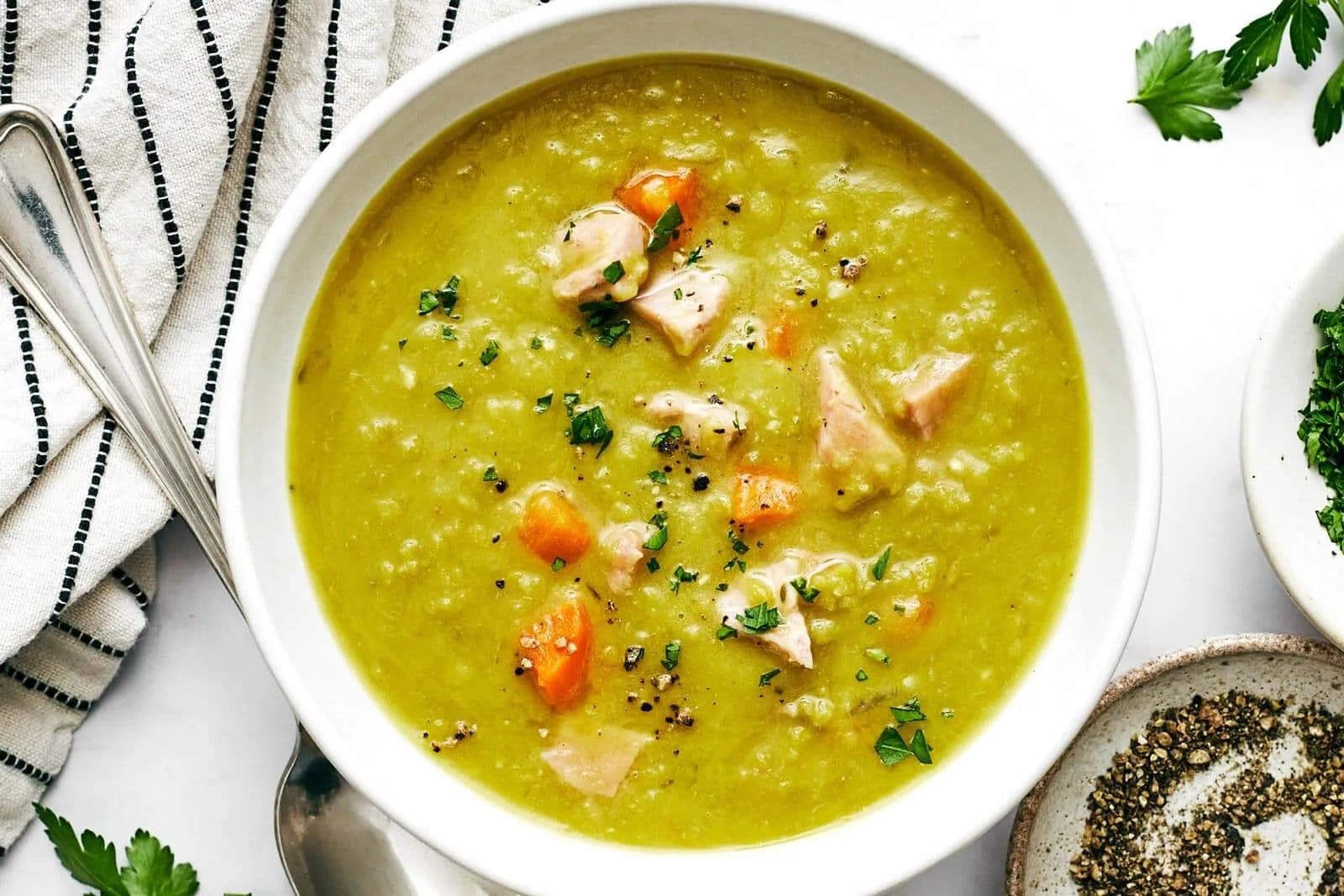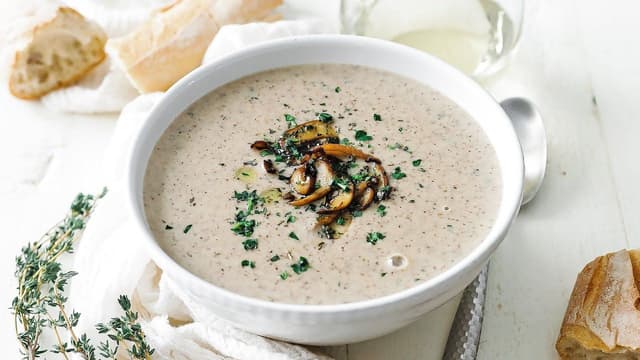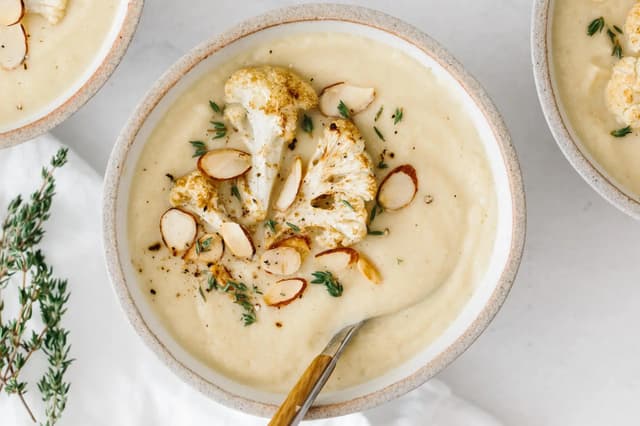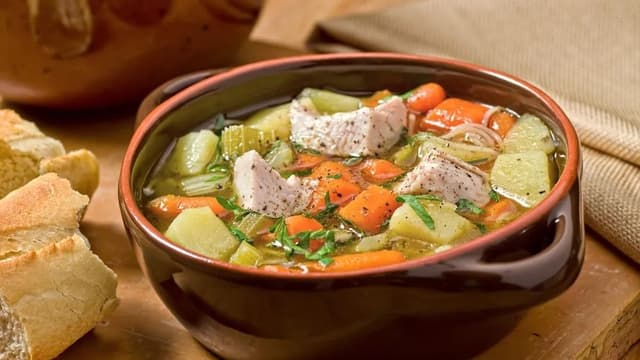Introduction
There’s something uniquely comforting about a steaming bowl of split pea soup. More than just a meal, it’s like a warm hug, perfect for chasing away the chill on a cool day or simply offering a moment of pure culinary solace. This classic dish has a way of making everything feel right with the world.
Beyond its immediate comfort, split pea soup is a powerhouse of nourishment, brimming with wholesome ingredients that are as good for the body as they are for the soul. It often carries a delightful nostalgic charm, whisking us back to cherished family meals and time-honored traditions, a testament to its enduring place in our hearts and kitchens.
Why Make This Delicious Recipe & When to Serve It
The irresistible appeal of homemade split pea soup lies in its incredible depth of flavor, especially when a smoky ham bone or hock is allowed to simmer gently with the peas, infusing the entire pot with its rich essence. The resulting thick, hearty texture is both profoundly satisfying and deeply comforting, a true balm on a blustery day. Plus, it’s wonderfully budget-friendly, relying on simple, inexpensive staples like dried split peas to create a truly magnificent meal.
This soup is wonderfully versatile, fitting a variety of occasions:
- Chilly Evenings: It's the quintessential cozy meal when the temperature drops, warming you from the inside out.
- Family Dinners: A wholesome and universally loved dish, it’s perfect for bringing everyone to the table, often sparking fond memories.
- Meal Prep Magic: This recipe makes a generous batch that stores and reheats beautifully, making it ideal for satisfying lunches or quick dinners throughout a busy week.
- Cozy Weekends: Imagine a pot simmering slowly on a Sunday, filling your home with the most incredible, welcoming aromas.
- Post-Holiday Delight: It’s a fantastic and flavorful way to make the most of leftover ham bones after celebrations like Easter, Thanksgiving, or Christmas. The adaptability of split pea soup, fitting seamlessly into practical meal prepping as well as using celebratory leftovers, showcases its broad appeal in modern lifestyles, effectively bridging tradition with everyday convenience.

For any home cook, this split pea soup is a must-try. It’s surprisingly easy to make, even if you’re not a seasoned chef, and the process itself is a rewarding experience. The payoff is a deeply flavorful, nourishing, and utterly delicious meal that you’ll be proud to serve.
Basic Ingredients (Serves 6-8 people)
This recipe is designed to serve 6-8 people, making it perfect for family meals or for having delicious leftovers. The careful selection and preparation of each component contribute to the soup's final, wonderful character.
- 2 tablespoons Olive Oil: This heart-healthy oil is used for sautéing the aromatic vegetables, building a foundational layer of flavor and helping them soften beautifully before the simmering process begins.
- 1 large Onion, chopped (about 2 cups): An essential aromatic, the onion provides a sweet and savory depth when sautéed, forming the backbone of the soup’s complex flavor base.
- 2-3 Carrots, peeled and chopped (about 1.5-2 cups): These vibrant roots add a natural sweetness and a lovely color, along with a slightly earthy note that balances the savory elements and contributes to the hearty texture.
- 2-3 Celery Stalks, chopped (about 1-1.5 cups): Celery brings a subtle, earthy, and slightly peppery flavor, enhancing the aromatic complexity of the soup and harmonizing wonderfully with the other vegetables.
- 2 cloves Garlic, minced: This pungent allium infuses the soup with a warm, savory aroma and flavor that deepens during cooking, adding a classic and indispensable taste that many adore.
- 1 pound (about 2 ¼ cups) Green Split Peas, rinsed: The star of the show, these dried peas break down during their slow simmer, creating the soup’s characteristic thick, creamy texture and delivering its signature earthy, satisfying flavor.
- 1 meaty Ham Bone or 1-2 Smoked Ham Hocks (approx. 1.5 lbs): This is crucial for imparting a rich, smoky, and deeply savory pork flavor throughout the soup; the tender meat can also be shredded and added back for extra heartiness and texture. The choice between a bone and hocks can influence both flavor intensity and the amount of meat retrievable.
- 8 cups Chicken Broth (or Vegetable Broth for a vegetarian base): This provides the primary cooking liquid, adding a significant layer of savory flavor that complements the peas and ham, or provides a rich umami base in vegetarian versions.
- 2 Bay Leaves: These aromatic leaves lend a subtle, earthy, and slightly floral undertone that enhances other savory notes, adding a layer of quiet complexity to the soup’s overall flavor profile.
- 1 teaspoon Dried Thyme (or 1 tablespoon fresh thyme): This classic herb contributes warm, earthy, and slightly minty notes, complementing the ham and vegetables beautifully and adding a traditional seasoning touch that is both familiar and welcome.
- ½ teaspoon Dried Marjoram (optional, but recommended): A cousin to oregano but with a milder, sweeter, and more floral character, marjoram adds a delicate herbaceous layer that subtly enhances the soup's overall aroma and taste.
- Salt and freshly ground Black Pepper to taste: These essential seasonings are fundamental for enhancing all the individual flavors in the soup, bringing them together harmoniously and allowing for precise adjustment to achieve the perfect final taste.
- 1 medium Potato, peeled and diced (optional, for thickness): The starch released from the potato as it cooks helps to naturally thicken the soup, contributing to a creamier, more luxurious consistency without significantly altering the primary flavor profile. This also caters to preferences for thicker soups without other adjustments.

Understanding the role of each ingredient, even common ones like onions or carrots, can transform the cooking process from simply following steps to appreciating the science of flavor building. For instance, knowing that onions form a "flavor base" or that carrots "balance savory elements" empowers more informed cooking.
Step-by-Step Preparation
Following these steps meticulously will guide you to a perfect pot of split pea soup.
1. Sauté the Aromatics: In a large stockpot or Dutch oven, heat the 2 tablespoons of olive oil over medium heat. Add the chopped onion, carrots, and celery. Cook, stirring occasionally, for 8-10 minutes, until the vegetables soften and the onion becomes translucent. Then, add the minced garlic and cook for one more minute until fragrant, ensuring it doesn't burn, as this preserves its sweet aroma rather than imparting bitterness.
2. Build the Flavor Base: To the pot, add the rinsed green split peas, the ham bone (or smoked ham hocks), chicken broth (or vegetable broth), bay leaves, dried thyme, and dried marjoram (if using). If you've opted to include the diced potato for added thickness, now is the time to add it. Stir all these ingredients together thoroughly to combine them well.
3. Simmer to Perfection: Bring the mixture to a rolling boil, then immediately reduce the heat to low. Cover the pot and let the soup simmer gently for 1.5 to 2 hours. It's important to stir occasionally, especially towards the end of cooking, to prevent the increasingly thick peas from sticking to the bottom and potentially scorching, which can introduce an undesirable burnt flavor. The soup is ready when the peas are very tender and have started to fall apart, and any meat on the ham bone/hocks is soft and yielding.
4. Prepare the Ham: Carefully lift the ham bone (or ham hocks) from the soup and place it on a cutting board to cool for a few minutes until it's safe to handle. Once manageable, pull or cut the meat away from the bone(s). Discard the bone(s) and any large pieces of fat or skin. Shred or dice the reserved ham meat and set it aside. Remember to also find and discard the bay leaves from the soup pot.
5. Create the Perfect Texture (Optional Pureeing): For a smoother, creamier soup, you can puree a portion or all of it. An immersion blender used directly in the pot is excellent for this, allowing you to blend until your preferred consistency is achieved. Alternatively, carefully ladle a few cups of the soup into a regular blender (never fill more than halfway with hot liquid, and ensure the lid is vented to release steam) and blend until smooth, then pour the pureed portion back into the pot. If you enjoy a more rustic, chunky texture, you can minimize or skip this pureeing step entirely, respecting that "perfect" can mean different things to different palates.
6. Finish and Season: Stir the reserved diced or shredded ham meat back into the soup. Bring the soup back to a gentle simmer. Now, taste the soup carefully and season generously with salt and freshly ground black pepper as needed to enhance all the flavors. Allow it to simmer for another 10-15 minutes, uncovered if you'd like it to thicken slightly more, for all the flavors to meld beautifully and to ensure the added ham is heated through. If the soup is thicker than you prefer, stir in a little more broth or hot water until it reaches your desired consistency.

Tips for the Perfect Recipe
A few extra pointers can elevate your split pea soup from great to absolutely sensational.
Flavor Boosters:
- Quality Ham Product: The foundation of a truly memorable split pea soup often comes from a good quality, smoky ham bone or hock. This ingredient is crucial for imparting that deep, savory, and smoky flavor that defines the classic dish.
- Fresh Herbs if Possible: While dried herbs are convenient and effective, adding a small amount of chopped fresh thyme or parsley near the end of cooking or as a garnish can introduce a vibrant freshness.
- Don't Under-Season: Soups, especially hearty ones like this, often require a good amount of salt to bring all the individual flavors to life. Taste and adjust seasoning, particularly salt and pepper, just before serving.
- A Splash of Acidity (Optional): If your finished soup tastes a little flat or heavy, a tiny splash of apple cider vinegar or fresh lemon juice stirred in at the very end can work wonders. This touch of acidity can brighten and balance the rich, earthy flavors, much like lemon juice is used in yellow split pea soup to enhance its profile.
Texture Triumphs:
- Rinse Your Peas: Always give your dried split peas a good rinse under cold water to remove any dust or small debris before cooking. Soaking is generally not required for split peas as they cook relatively quickly and break down nicely on their own.
- Pea Freshness Matters: The age of your split peas can significantly impact their cooking time and final texture. Old split peas may take much longer to soften or, in some cases, might not soften properly at all, potentially resulting in a gritty or uneven texture. Using peas well within their best-by date is advisable for the creamiest results.
- Control the Creaminess: An immersion blender offers the easiest way to achieve your desired level of smoothness directly in the pot. For an exceptionally silky, velvety soup, you can take the extra step of passing the puréed soup through a fine-mesh sieve.
- Natural Thickening: The optional diced potato contributes starch that naturally thickens the soup as it cooks. If your soup isn't as thick as you'd like, simmering it uncovered for a little longer will allow excess liquid to evaporate, or a cornstarch slurry can be used as a quick thickener.
Presentation Pointers:
- Garnish Generously: A simple garnish can transform the look of your soup and add delightful textural and flavor contrasts. Consider a swirl of cream or plain yogurt, a sprinkle of fresh parsley or chives, or a handful of crunchy homemade croutons. This attention to detail aligns with creating an appealing dish.
- Contrasting Colors: To make the green soup even more visually appealing, a few reserved pieces of cooked carrot, finely diced, or a light dusting of paprika can add an attractive pop of color.

Serving Ideas
Split pea soup is wonderfully versatile and can be served in many delightful ways.
Classic Comfort:
- Crusty Bread: There's arguably no better companion than a thick slice of warm, buttered crusty bread, a baguette, or hearty sourdough for dipping and soaking up every last bit of soup. For many, the bread is an integral part of the experience, not just a side.
- Simple Green Salad: A crisp green salad tossed with a light vinaigrette dressing offers a refreshing and balancing contrast to the richness and heartiness of the soup.

Garnish Extravaganza: The trend towards customizable meals means you can offer a variety of toppings, allowing everyone to personalize their bowl.
- Homemade Croutons: These add a satisfying crunch and can be seasoned with herbs or garlic for extra flavor.
- Fresh Herbs: A sprinkle of finely chopped fresh parsley, chives, or even a touch of fresh dill can brighten the soup's flavor and add visual appeal.
- A Dollop of Dairy (or non-dairy): A spoonful of sour cream, plain Greek yogurt, crème fraîche, or a drizzle of heavy cream can add a touch of richness and a pleasant tangy or cool contrast.
- Crispy Bacon Bits or Pancetta: For those who love extra smokiness and a savory crunch, cooked and crumbled bacon or pancetta makes an excellent topping.
- Shredded Cheese: A modest sprinkle of grated Parmesan, sharp cheddar, or even a smoked gouda can melt beautifully into the hot soup, adding another layer of flavor.

Heartier Meals:
- Grilled Cheese Sandwich: Take the comfort food experience to the next level by pairing the soup with a classic, gooey grilled cheese sandwich.
- As a Main Course with Roasted Vegetables: Serve a generous bowl of split pea soup as the star of the meal, accompanied by a side of colorful roasted root vegetables or steamed greens for a very filling, balanced, and nutritious dinner.
Tips for Storing and Reheating
Split pea soup is fantastic for leftovers, and these tips will help you enjoy it just as much the next day (or month!).
Storing Leftovers
- Cool Completely: It's crucial to allow the soup to cool down to room temperature before storing it. This helps prevent bacterial growth and minimizes condensation inside the container.
- Airtight Containers: Transfer the cooled soup into airtight containers. This practice is key to maintaining its freshness, preventing it from drying out, and stopping it from absorbing any stray odors from your refrigerator.
- Refrigerate Promptly: Once cooled and containerized, store the soup in the refrigerator. It will keep well for up to 4-5 days.
- Freezing for Future Feasts: One of the best qualities of split pea soup is how beautifully it freezes. Ladle cooled soup into freezer-safe containers or heavy-duty freezer bags, making sure to leave about an inch of headspace to allow for expansion as it freezes. It can be stored in the freezer for up to 3-6 months, making it an excellent choice for batch cooking and future easy meals.
Reheating Tips
- Thawing: For the best texture and to ensure even reheating, thaw frozen soup overnight in the refrigerator whenever possible.
- Stovetop Reheating (Recommended): Gently reheat the soup in a saucepan over medium-low heat. Stir it frequently to prevent sticking and ensure it heats evenly until it's pleasantly hot all the way through. Avoid bringing it to a rapid boil, which can sometimes affect the texture.
- Microwave Reheating: Individual portions can also be reheated in the microwave. Use a microwave-safe bowl, cover it loosely to prevent splatters, and heat in intervals (e.g., 1-2 minutes), stirring between intervals, until the soup is thoroughly heated.
- Adjust Consistency: Split pea soup has a natural tendency to thicken quite considerably as it chills. This is due to the starches from the peas continuing to gelatinize and absorb liquid. When reheating, you will likely need to add a splash of water, broth, or even a little milk to thin it out to your preferred consistency. Stir well after adding any liquid to incorporate it smoothly.
The excellent freezability of this soup makes it an ideal candidate for meal prepping, aligning perfectly with modern demands for convenient, yet wholesome homemade meals.
Conclusion
In essence, split pea soup is a timeless classic that offers a truly delightful combination of hearty nourishment, deep, savory flavor, and an unparalleled comforting warmth. It’s a simple joy to create in your own kitchen, promising a rewarding meal that soothes the soul, satisfies the appetite, and perhaps even brings back a few fond memories, so why not gather your ingredients and whip up a pot of this beloved soup today?.
Frequently Asked Questions
Q: Do I need to soak split peas before cooking them?
A: No, soaking is generally not necessary for split peas. They are relatively small and cook more quickly than many other dried legumes, usually becoming perfectly tender within 1.5 to 2 hours of simmering.
Q: How can I make my split pea soup thicker if it’s too thin?
A: The soup naturally thickens as it cools. For quicker results, you can simmer it uncovered for a bit longer, puree a larger portion of it, or stir in a slurry made by whisking one tablespoon of cornstarch with one tablespoon of cold water until smooth.
Q: Can I make split pea soup vegetarian or vegan?
A: Absolutely! To make a vegetarian version, simply omit any ham products and use a good quality vegetable broth instead of chicken broth. Ensure you use plenty of aromatic vegetables and herbs to build a rich, satisfying flavor base.
Q: How long does split pea soup last, and can I freeze it?
A: Leftover split pea soup will keep well in an airtight container in the refrigerator for about 4-5 days. It also freezes exceptionally well for up to 3-6 months, making it a fantastic option for enjoying a quick, homemade meal later on.
Works cited
- Classic Split Pea Soup - Downshiftology, accessed May 20, 2025, https://downshiftology.com/recipes/split-pea-soup/
- Split pea soup is a nourishing and hearty dish that warms the soul with its rich flavors and creamy texture. - COLLARD VALLEY COOKS, accessed May 20, 2025, https://www.collardvalleycooks.com/split-pea-soup.html
- Split Pea Soup | Blue Jean Chef - Meredith Laurence, accessed May 20, 2025, https://bluejeanchef.com/recipes/split-pea-soup/
- Pressure Cooker Split Pea Soup Recipe - Allrecipes, accessed May 20, 2025, https://www.allrecipes.com/recipe/246119/pressure-cooker-split-pea-soup/
- Vegetarian Split Pea Soup Recipe - The Mom 100, accessed May 20, 2025, https://themom100.com/recipe/vegetarian-split-pea-soup/
- Split Pea Soup- The soup that is worth eating all year round! - Batel's Kitchen, accessed May 20, 2025, https://batelskitchen.com/split-pea-soup-the-soup-that-is-worth-eating-all-year-round/
- Split Pea Soup Recipe, accessed May 20, 2025, https://www.allrecipes.com/recipe/13384/split-pea-soup/
- Split Pea Soup - Simply Recipes, accessed May 20, 2025, https://www.simplyrecipes.com/recipes/split_pea_soup/
- Parker's Split Pea Soup Recipe | Ina Garten - Food Network, accessed May 20, 2025, https://www.foodnetwork.com/recipes/ina-garten/parkers-split-pea-soup-recipe-1916855
- Split Pea Soup Recipe | Food Network, accessed May 20, 2025, https://www.foodnetwork.com/recipes/split-pea-soup-recipe-1918556
- Yellow Split Pea Soup - Simply Recipes, accessed May 20, 2025, https://www.simplyrecipes.com/recipes/yellow_split_pea_soup/
- www.allrecipes.com, accessed May 20, 2025, https://www.allrecipes.com/recipe/13384/split-pea-soup/#:~:text=Recipe%20Tip,soup%20reaches%20the%20desired%20consistency.











